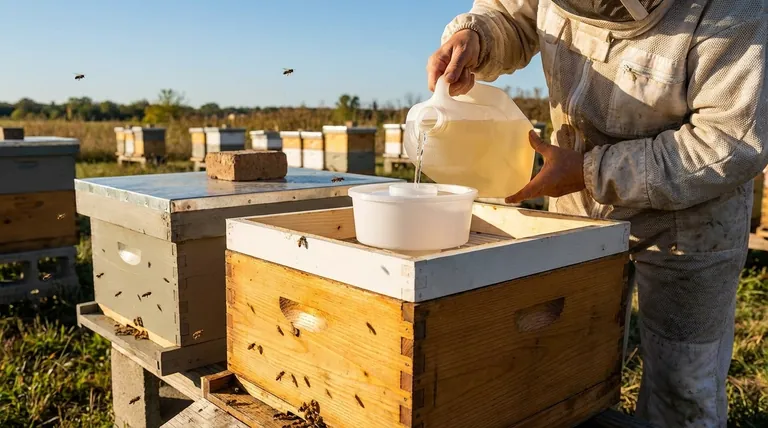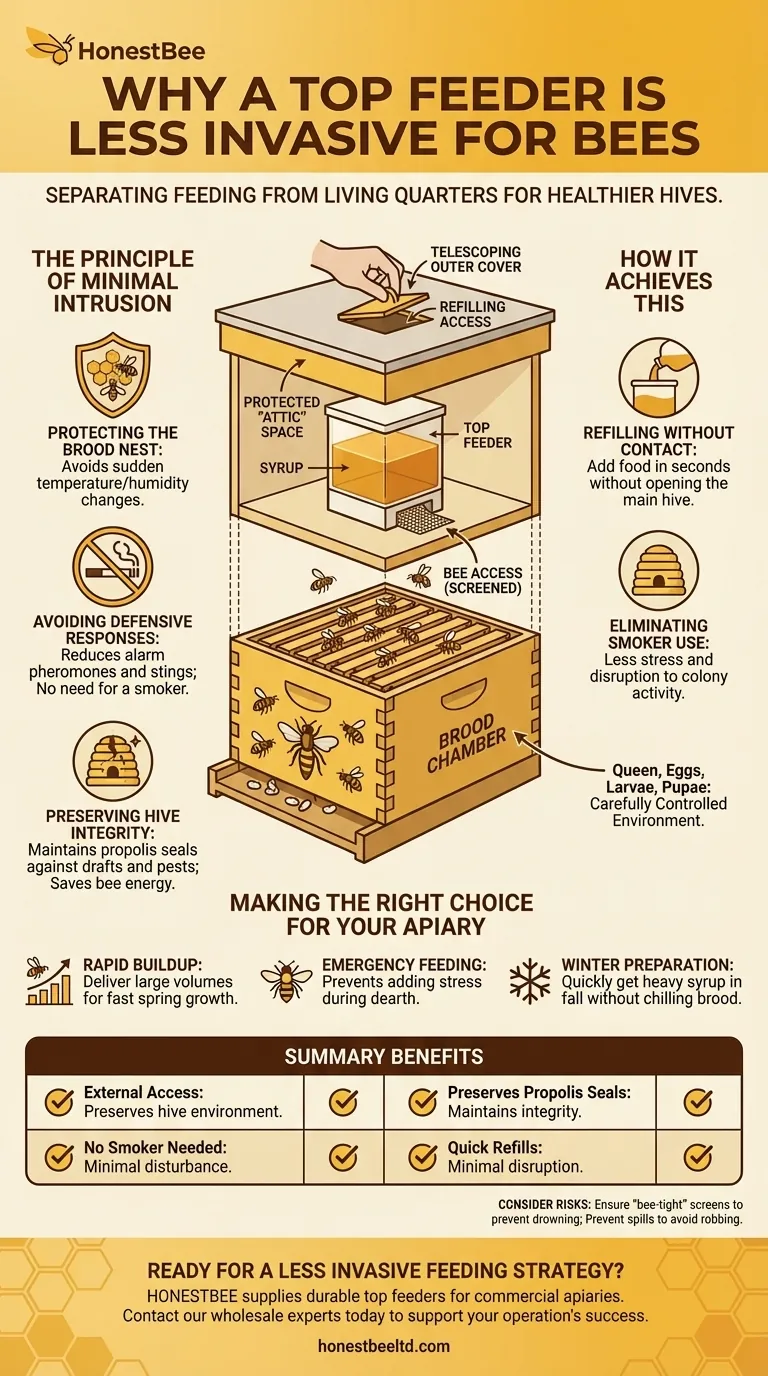At its core, a top feeder is considered less invasive because it creates a clear separation between the feeding area and the colony's living quarters. This design allows you to add food without ever opening the main hive body where the queen and brood reside, which significantly reduces stress on the bees and the beekeeper.
The primary advantage of a top feeder is not its location, but its function as an external "service hatch." By isolating the feeding process from the brood chamber, you preserve the colony's internal environment and avoid triggering defensive behavior.

The Principle of Minimal Intrusion
To understand why a top feeder is less invasive, you must first understand why disturbing a hive is a significant event for the colony.
Protecting the Brood Nest
The brood nest is the heart of the colony, containing the queen, eggs, larvae, and pupae. It is a carefully controlled environment.
Opening the brood chamber exposes it to sudden changes in temperature and humidity, forcing the bees to expend precious energy restoring the balance.
Avoiding Defensive Responses
When you open a hive, the bees often perceive it as a direct threat from a large predator. This triggers a defensive response.
This response involves alarm pheromones, which can lead to stings. It also requires the use of a smoker to calm the bees, which introduces another disruptive element into the hive.
Preserving Hive Integrity
Bees use a resinous substance called propolis to seal every crack and gap in their home, creating a barrier against drafts, pests, and disease.
Every time you break open a hive body, you break these propolis seals. The colony must then divert resources and worker-hours away from other tasks, like foraging and brood care, to repair the damage.
How a Top Feeder Achieves This
A top feeder is specifically engineered to allow feeding while respecting the colony's natural integrity.
Physical Separation
The feeder is placed on top of the uppermost hive box. A separate, empty hive box is then placed around the feeder to enclose it, creating a protected "attic" space.
The bees access the syrup from below through a screened opening, while the beekeeper accesses the feeder from above by simply removing the outer cover.
Refilling Without Contact
To refill the feeder, you lift the telescoping outer cover and a small lid on the feeder itself to pour in syrup. The actual living space of the hive is never opened or exposed.
This means you can check and refill food levels in seconds, often without the bees even being aware of your presence.
Eliminating the Need for a Smoker
Because you are not entering the main hive and triggering a defensive response, there is typically no need to use a smoker. This further reduces the stress and disruption to the colony's normal activity.
Understanding the Trade-offs and Risks
While less invasive, a top feeder requires correct setup to be effective and safe for your bees.
The Risk of Drowning
The most significant risk is bees gaining access to the main syrup reservoir and drowning.
It is critical to ensure any screens or hardware cloth separating the bees from the syrup are 'bee tight.' Small gaps can be deadly, so inspect your feeder for proper construction before use.
Preventing Robbing
A poorly sealed or overflowing feeder can leak syrup down the outside of the hive. This scent will attract robber bees from other colonies, which can lead to a fight that devastates your hive.
Using an empty hive box around the feeder helps contain minor spills and makes the hive more defensible against this threat.
Weight and Accessibility
Top feeders, when full, can be quite heavy. This can be a consideration for beekeepers with physical limitations, especially when hives are stacked high.
Making the Right Choice for Your Apiary
Your feeding strategy should align with your specific management goals and the needs of your colony.
- If your primary focus is rapid population buildup: A top feeder is highly effective because you can deliver large volumes of syrup with minimal disturbance, encouraging fast growth in the spring.
- If your primary focus is emergency feeding during a dearth: The low-disturbance nature of a top feeder prevents adding unnecessary stress to a colony that is already struggling for resources.
- If your primary focus is winter preparation: Top feeders are excellent for getting heavy syrup into a hive quickly in the fall without repeatedly chilling the brood nest during inspections.
By understanding the principle of minimal invasion, you can use a top feeder not just as a tool, but as a key part of a respectful and effective beekeeping strategy.
Summary Table:
| Feature | Benefit |
|---|---|
| External Access | Feed without opening the main brood chamber, preserving hive environment. |
| No Smoker Needed | Minimal disturbance avoids triggering defensive bee behavior. |
| Preserves Propolis Seals | Maintains hive integrity against drafts and pests. |
| Quick Refills | Replenish syrup in seconds with minimal disruption to colony activity. |
Ready to implement a less invasive feeding strategy for your apiary? HONESTBEE supplies durable, well-designed top feeders and other essential beekeeping supplies to commercial apiaries and distributors. Our equipment is built with the principles of minimal intrusion in mind, helping you maintain healthier, more productive colonies. Contact our wholesale experts today to discuss your needs and discover how we can support your operation's success.
Visual Guide

Related Products
- Rapid Bee Feeder White Plastic 2L Round Top Feeder for 8 or 10-Frame Bee Hives
- Professional Hive Top Bee Feeder for Beekeeping
- HONESTBEE Professional Hive Top Bee Feeder Feeding Solution
- HONESTBEE Round Hive Top Bee Feeder for Syrup
- Professional Hive Front Entrance Bee Feeder
People Also Ask
- Can you dilute honey and feed it to the bees? Understand the Critical Risks and Safe Practices
- How do you set up and use a top feeder for bees? A Step-by-Step Guide for Safe Feeding
- Can sugar syrup contaminate the honey crop? A Beekeeper's Guide to Protecting Honey Purity
- What are the recommended sugar-to-water ratios for making sugar syrup for bees? Optimize Your Hive's Health
- What can the round hive top feeder be used for? A Guide to Efficient, Safe Bee Feeding



















